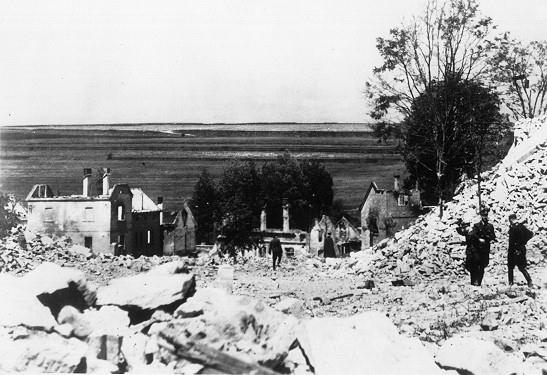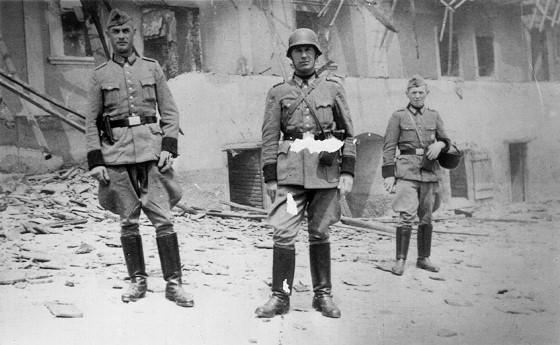
The Liquidation of Lidice

| The bodies of the men and boys over age 16 of Lidice, Czechoslovakia, murdered by the Nazis on June 10, 1942, in reprisal for the assassination of SS Leader Reinhard Heydrich. Below: SS officers sift through the rubble of Lidice. |

| Below: Members of the Schutzpolizei (German protective police) pose in front of the Horak family farm, which they just destroyed. |

On May 27, 1942, SS-Obergruppenführer Reinhard Heydrich, Deputy Reich Protector of Bohemia and Moravia, had been attacked in Prague by Free Czech agents who were trained in England and brought to Czechoslovakia to assassinate him. They shot at Heydrich as his car slowed to round a sharp turn, then threw a bomb which exploded, mortally wounding him. Heydrich managed to get out of the car, draw his pistol and shoot back at the assassins before collapsing in the street.
Heydrich survived for several days, but died on June 4th from blood poisoning brought on by fragments of auto upholstery, steel, and his own uniform that had lodged in his spleen.
In Berlin, the Nazis staged a highly elaborate funeral with Hitler calling Heydrich "the man with the iron heart."
See also: The History Place - Biography of Reinhard Heydrich
Meanwhile the Gestapo and SS hunted down and murdered Czech agents, resistance members, and anyone suspected of being involved in Heydrich's death, totaling over 1000 persons. In addition, 3000 Jews were deported from the ghetto at Theresienstadt for extermination. In Berlin 500 Jews were arrested, with 152 executed as a reprisal on the day of Heydrich's death.
As a further reprisal, Hitler ordered the small Czech mining village of Lidice to be liquidated on the fake charge that it had aided the assassins.
In one of the most infamous single acts of World War II, all 172 men and boys over age 16 in the village were shot while the women were deported to Ravensbrück concentration camp where most died. Ninety young children were sent to the concentration camp at Gneisenau, with some taken later to Nazi orphanages if they were German looking.
The village of Lidice was then destroyed building by building with explosives, then completely leveled until not a trace remained, with seeds being planted over the flattened soil. The name was then removed from all German maps.
(Photo credits: top, middle - Library of Congress, bottom - USHMM, all courtesy of USHMM Photo Archives)
Return to The History Place - World War II Timeline: 1942
The History Place Main Page
Terms of use: Private home/school non-commercial, non-Internet re-usage only is allowed of any text, graphics, photos, audio clips, other electronic files or materials from The History Place.